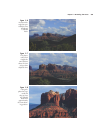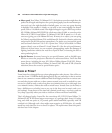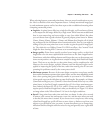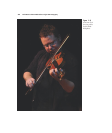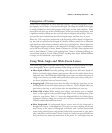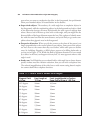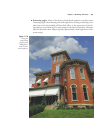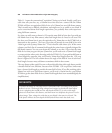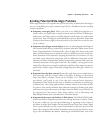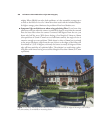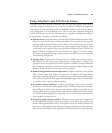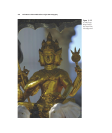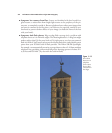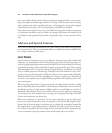Avoiding Potential Wide-Angle Problems
Wide-angle lenses have a few quirks that you’ll want to keep in mind when shooting so
you can avoid falling into some common traps. Here’s a checklist of tips for avoiding
common problems:
■ Symptom: converging lines. Unless you want to use wildly diverging lines as a
creative effect, it’s a good idea to keep horizontal and vertical lines in landscapes,
architecture, and other subjects carefully aligned with the sides, top, and bottom
of the frame. That will help you avoid undesired perspective distortion. Sometimes
it helps to shoot from a slightly elevated position so you don’t have to tilt the cam-
era up or down.
■ Symptom: color fringes around objects. Lenses are often plagued with fringes of
color around backlit objects, produced by chromatic aberration, which comes in two
forms: longitudinal/axial, in which all the colors of light don’t focus in the same
plane; and lateral/transverse, in which the colors are shifted to one side. Axial chro-
matic aberration can be reduced by stopping down the lens, but transverse CA can-
not. Both can be reduced by using lenses with low diffraction index glass (or ED
elements, in Nikon nomenclature) and by incorporating elements that cancel the
chromatic aberration of other glass in the lens. For example, a strong positive lens
made of low dispersion crown glass (made of a soda-lime-silica composite) may be
mated with a weaker negative lens made of high-dispersion flint glass, which con-
tains lead.
■ Symptom: lines that bow outward. Some wide-angle lenses cause straight lines to
bow outwards, with the strongest effect at the edges. In fisheye (or curvilinear)
lenses, this defect is a feature, as you can see in Figure 11.11. When distortion is
not desired, you’ll need to use a lens that has corrected barrel distortion.
Manufacturers like Nikon do their best to minimize or eliminate it (producing a
rectilinear lens), often using aspherical lens elements (which are not cross-sections
of a sphere). You can also minimize barrel distortion simply by framing your photo
with some extra space all around, so the edges where the defect is most obvious can
be cropped out of the picture. Some image editors, such as Photoshop and
Photoshop Elements have a lens distortion correction feature.
■ Symptom: dark corners and shadows in flash photos. The Nikon D7000’s built-
in electronic flash is designed to provide even coverage for lenses as wide as 17mm.
If you use a wider lens, you can expect darkening, or vignetting, in the corners of
the frame. At wider focal lengths, the lens hood of some lenses (my 18mm-70mm
lens is a prime offender) can cast a semi-circular shadow in the lower portion of the
frame when using the built-in flash. Sometimes removing the lens hood or zoom-
ing in a bit can eliminate the shadow. Mounting an external flash unit, such as the
Chapter 11 ■ Working with Lenses 367



